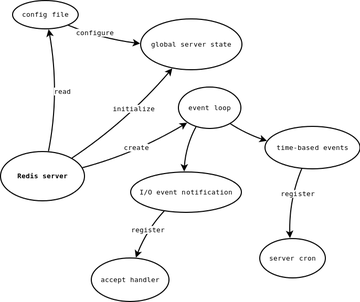Redis: under the hood

How does the Redis server work?
I was curious to learn more about Redis’s internals, so I’ve been familiarizing myself with the source, largely by reading and jumping around in Emacs. After I had peeled back enough of the onion’s layers, I realized I was trying to keep track of too many details in my head, and it wasn’t clear how it all hung together. I decided to write out in narrative form how an instance of the Redis server starts up and initializes itself, and how it handles the request/response cycle with a client, as a way of explaining it to myself, hopefully in a clear fashion. Luckily, Redis has a nice, clean code base that is easy to read and follow along. Armed with a TAGSfile, my $EDITOR, and GDB, I set out to see how it all works under the hood. (Incidentally, I was working with the Redis code base as ofcommit b4f2e41. Of course, internals such as I outline below are subject to change. However, the broad architecture of the server is unlikely to change very much, and I tried to keep that in mind as I went along.)
This article examines server startup and takes a high-level view of the request/response processing cycle. In a subsequent article, I’ll dive in to greater detail and trace a simple SET/GET command pair as they make their way through Redis.
Startup
Let’s begin with the main() function in redis.c.

Beginning global server state initialization
First, initServerConfig() is called. This partially initializes a variable server, which has the type struct redisServer, that serves as the global server state.
// redis.h:338
struct redisServer {
pthread_t mainthread;
int port;
int fd;
redisDb *db;
// ...
};
// redis.c:69
struct redisServer server; /* server global state */
There are a huge number of members in this struct, but they generally fall into the following categories:
- general server state
- statistics
- configuration from config file
- replication
- sort parameters
- virtual memory config, state, I/O threads, & stats
- zip structure
- event loop helpers
- pub/sub
分享到:












相关推荐
redis:7.0.8 docker镜像
Redis:6.2.7版本的配置文件redis.conf
它没有网络模块,因此您可以自由配置自己的模块,也可以使用默认模块( )例cpp_redis :: client cpp_redis::client client;client.connect();client.set( " hello " , " 42 " );client.get( " hello " , [](cpp_...
ubuntu下docker安装redis:6.2.14
Redis-sentinel是Redis的作者antirez完成的,因为Redis实例在各个大公司的应用,每个公司都需要一个Redis集群的管理工具,被迫都自己写管理工具来管理Redis集群,antirez考虑到社区的急迫需要(详情),花了几个星期写...
接下来,我们需要编译和安装 Redis: `make install` 这将将 Redis 编译并安装到系统中。 配置 Redis 安装完成后,我们需要配置 Redis,以便它能够正确地运行。我们需要修改 `redis.conf` 文件,以添加密码认证...
使用redis:encode/1函数以Redis数据格式编码Erlang术语: % integer redis : encode ( 1 ). % simple string redis : encode (<< " test " >>). % bulk string redis : encode ({ bulk_string , << " ...
安装npm install --save keyv ioredis @microlink/keyv-redis用法const Keyv = require ( 'keyv' )const keyv = new Keyv ( 'redis://user:pass@localhost:6379' ) 任何有效的选项都将直接通过。 const keyv = new ...
Redis 是一个高性能的键值对数据库,常被用于构建数据缓存、消息队列和数据库。在Linux系统中,Redis的安装通常涉及下载源码、编译和配置等步骤。这里我们将详细介绍如何处理"最新版linux redis-6.2.1.tar.gz"这个...
Redis命名空间Redis的::命名空间提供了一个接口,您的命名空间的子集密钥空间(例如,具有共同的开始键),并要求宝石。 require 'redis-namespace'# => trueredis_connection = Redis . new# => #<Redis>namespaced...
Redis 6.2.1 现已发布,该版本升级迫切性程度为低:修复了编译问题。具体更新内容如下: Bug 修复 修复带有已删除记录的 stream 的 sanitize-dump-payload(#8568) 防止将 client-query-buffer-limit 配置设置为...
独库redis dokku 的官方 redis 插件。 当前默认安装 。...redis:backup <service> <bucket> [--use-iam] # creates a backup of the redis service to an existing s3 bucket redis:backup-auth <service>
redis:6.0.4镜像
它没有网络模块,因此您可以自由配置自己的模块,也可以使用默认模块( )例cpp_redis :: client cpp_redis::client client;client.connect();client.set( " hello " , " 42 " );client.get( " hello " , [](cpp_...
wallproxy Errno 10054 解决方法
Maven坐标:org.springframework.data:spring-data-redis:2.0.9.RELEASE; 标签:springframework、data、spring、redis、中英对照文档、jar包、java; 使用方法:解压翻译后的API文档,用浏览器打开“index.html”...
Redis 是一个开源的内存数据结构存储系统,常被用作数据库、缓存和消息代理。在Windows环境下,Redis 的安装和使用与在Linux系统中有所不同。这里我们将详细讨论Windows版Redis 5.0.14的相关知识点。 1. **Redis ...
安装将此行添加到应用程序的 Gemfile 中: gem 'pooled_redis'用法使用Redis.new支持的选项将redis部分添加到您的database.yml development : redis : db : 2production : redis : url : ' redis://mymaster ' ...
redis::server定义类型 redis::sentinel限制——操作系统兼容性等等。为 redis 模块做贡献概述此模块安装并配置同一节点上的多个 redis 实例的基本配置。它通过 REPO 或源代码安装 redis。( http://redis.io/ ) 它还...
用于 Rust 的 Redis 库redis-rs Redis-rs...fn fetch_an_integer() -> redis::RedisResult<isize> { // connect to redis let client = redis::Client::open("redis://127.0.0.1/")?; let mut con = client.get_connect